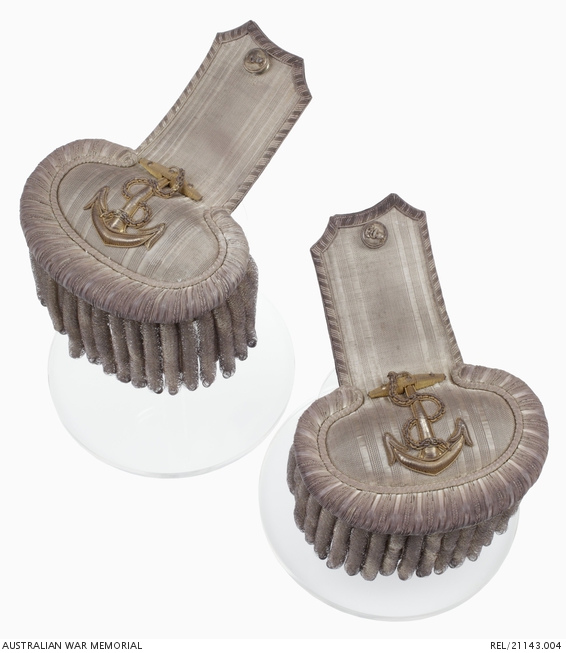| Place | Oceania: Australia, Victoria |
|---|---|
| Accession Number | REL/21143.004 |
| Collection type | Heraldry |
| Object type | Uniform |
| Physical description | Leather, Nickel Silver, Silk, Silver, Silver bullion, Silver bullion wire, Silver lace |
| Maker |
Buckmaster & Co |
| Place made | United Kingdom: England, Greater London, London |
| Date made | c 1860-1861 |
| Conflict |
Australian Colonial Forces, 1854-1900 |
Officer's full dress epaulettes : Lieutenant F O Handfield, Victorian Colonial Navy

Pair of Victorian (Colonial) Volunteer Navy officer's epaulettes covered with silver lace and edged with a crescent of silver lace and braid. Each epaulette bears a silver bullion and wire thread embroidered fouled anchor, with a straight stock, for the rank of lieutenant. A silver Royal Navy officer's button with Queen Victoria crown, and fouled anchor with a straight stock, is attached to the neck edge of each epaulette. The lower edge of the crescent bears a row of 23 silver bullions, with a row of 22 smaller bullions inside it. The epaulettes are lined with black leather over the shoulder, while the inside of the crescent is lined with padded blue silk. The bullions are held in shape by a rigid crescent shaped board covered with white silk on the outside and lined with quilt blue silk on the inside. The epaulettes attach to the uniform by means of a long nickel silver slide, running the length of the leather lining, and a flat hook. The slides are stamped 'LEFT' and 'RIGHT' respectively and bear impressed manufacturer's details 'BUCKMASTER & Co LONDON'.
These epaulettes were worn by Lieutenant Frederick Oliver Handfield during his service in the Victorian Navy in the 1860s. Handfield was born to Commander Edward and Louisa Sarah (nee Coakley) Handfield in Dublin on 15 April 1830 and joined the Royal Navy as a cadet on his fourteenth birthday. Two years later he qualified as a midshipman and in June 1852 was appointed mate in HMS 'Royal William' and subsequently in HMS 'Trincomalee'.
For two years, between 1854 and 1856, he was posted to HMS 'Rattlesnake' as an acting lieutenant. In 1854 'Rattlesnake' was ordered to the Arctic in search of the 'Monongahela', lost in late 1853 and thought to have been taken up into the
arctic by the ice. Although the 'Rattlesnake' 'coasted up to the utmost limits of navigation allowed by the ice' nothing was found of the 'Monongahela', although local natives had reported seeing a ship of her description sailing toward the Arctic Ocean.
In all probability it was for this deployment that Handfield was awarded the Arctic Medal. The medal, seen on Handfield's uniform in the photograph held in the Memorial's collection (P01359.001), was lost while he attended a reception for the Duke of Edinburgh in Melbourne in November 1867.
Following postings to HM Ships 'London' and 'Trident', Handfield resigned from the Royal Navy to follow his brothers to Melbourne in 1858. In August 1861 he enlisted in the Victorian Navy and was posted as a mate to Her Majesty's Colonial Steam Sloop 'Victoria' under the command of Captain William Henry Norman.
Almost immediately after his posting, the 'Victoria' embarked for the Gulf of Carpentaria in search of the explorers William O'Hara Burke and William John Wills, feared lost in the interior the previous month. Accompanying the 'Victoria' was the 'Firefly', chartered to carry the explorer William Landsborough and his party for an overland trek in search of the missing men.
The 'Firefly' grounded on a reef in the Coral Sea during a gale and sustained considerable damage before being refloated. Captain Norman placed Handfield in charge of the crippled ship on 20 September prior to it being put under tow behind the 'Victoria', with the pumps going night and day to keep her afloat. It was then grounded on the banks of the Albert River and used as a depot for the exploration party. Handfield remained in charge of the depot until the wreck was abandoned, and the expedition left the area in early 1862. The 'Victoria' returned to Melbourne on 31 March 1862. Soon after returning Handfield married Mary Ellen Tatham at St Peters Church in Melbourne.
In January the following year, Handfield marched as part of the HMCSS 'Victoria' contingent in the Burke and Wills funeral procession. On 11 May 1865 he was appointed to the naval training ship, 'Sir Harry Smith', as sub-lieutenant and by September 1867 was a lieutenant in command of the vessel. During the latter years of his naval career he was made superintendant over both the 'Sir Harry Smith' and the prison hulk 'Deborah', now juvenile reformatory ships. He retired from the navy on 31 December 1870 and was working for the Education Department when he died on 18 July 1886.